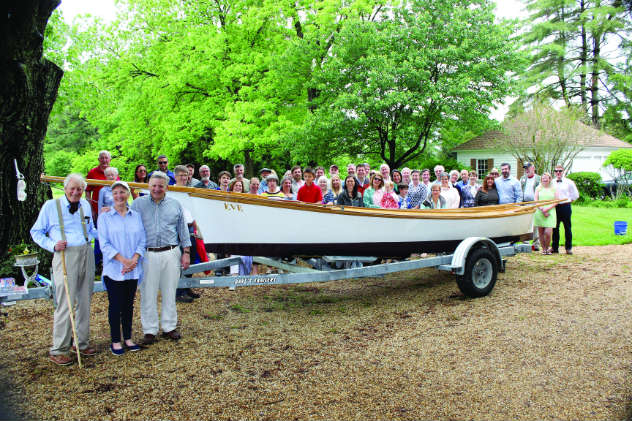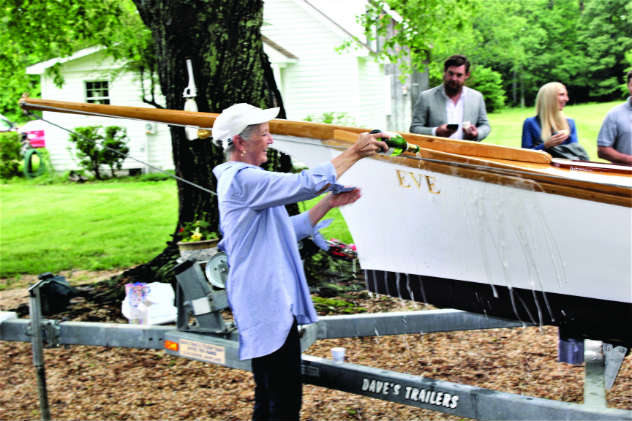An Unusual Launch Day for a 20-Foot Log Canoe
On a rainy day this spring, a ceremony was conducted on the banks of the St. Mary’s River that had not been seen in Chesapeake Bay country for nearly 45 years: the launching of a privately built log canoe.
John Cook, of Hollywood, MD, started almost two years ago with a block of solid pine made of five logs fastened together, and from them created a graceful and elegant twenty foot Tilghman Style Chesapeake Bay Sailing Log Canoe. Painted white with varnished bright work and the traditional elegant “long head” with clipper bow, gold leafed fiddle head, and varnished bowsprit, Eve sat on her trailer looking every bit like the thoroughbred she is.
John had arranged the launching at the home of his friend, noted artist Peter Eglie. Situated on a small bluff overlooking the St. Mary’s River, directly opposite St. Mary’s City, the location seemed to embody the sense of history that Eve represented. Launching ceremonies usually involve two parts: the christening, or naming of the vessel, and then sliding her into the water. This one turned out a bit differently.
After calling the group of about 50 well-wishers and supporters to order, John gave a brief introduction and recognized the support and help provided to him by such organizations as the Chesapeake Bay Maritime Museum and the Calvert Marine Museum, and many of the people in the audience, in the course of construction. The canoe was blessed by our host Peter Egeli, with the time honored invocation, “Bless this vessel and all who sail in her.” Eve Love, John Cook’s wife and the boat’s namesake, then dowsed the bow of Eve liberally with champagne.
What came next was a surprise. John announced that the previous week’s monsoon-like downpours had washed out the gravel road down to the intended launching site to the point that it was not safe. Because nature was not cooperating John said, “Since Eve can’t go to the river, we’ll bring the river to her.” He produced a five gallon bucket full of St. Marys River water and each person was given a Dixie cup to fill. On signal all splashed the river water on the canoe and wished her well. Not quite the traditional ending for the ceremony, but somehow it seemed appropriate.
Log canoes on the Chesapeake’s waters go all the way back to colonial times. They were the do- it-all workboats of the area’s watermen until changes in the fisheries, economics, and technology required bigger boats and engines. While most were centerboard sailing vessels, many were converted to power and many were built as powered boats. The type began to decline with the introduction of larger boats such as the
Skipjack and the ubiquitous Deadrise. The narrow hulls and sharp double ends of the canoes did not work well with the increasingly powerful engines that became available in the early twentieth century.
Eve is a Tilghman Island style canoe. That style is a relatively late development with fine lines and large sail plans designed primarily for racing. She joins a fleet of less than twenty log canoes still sailing. John Cook hopes to rekindle interest in the log canoe building process, and interest more people in building and racing these historic vessels.
~by Capt. Rick Franke







